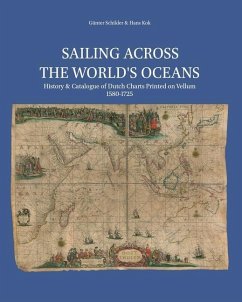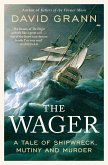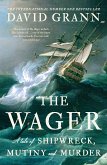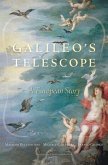Günter Schilder, Hans Kok
Sailing Across the World's Oceans
History & Catalogue of Dutch Charts Printed on Vellum 1580-1725
Günter Schilder, Hans Kok
Sailing Across the World's Oceans
History & Catalogue of Dutch Charts Printed on Vellum 1580-1725
- Gebundenes Buch
- Merkliste
- Auf die Merkliste
- Bewerten Bewerten
- Teilen
- Produkt teilen
- Produkterinnerung
- Produkterinnerung
Maps printed by commercial Amsterdam charts publishers between the sixteenth and the eighteenth century are spread all around the world. This illustrated cartobibligraphy describes and analyses about 150 charts, mostly found in international institutions. With over 800 full colour illustrations, many full page, it offers an overview of maps from Europe to the Indian and the Atlantic Ocean, the latter commonly called 'West-Indische Paskaerten'. The first part of the book contains six chapters that investigate the development of Amsterdam as a recognized centre for map production and…mehr
Andere Kunden interessierten sich auch für
![A Text-book of Ocean Meteorology: Comp. From the Sailing Directories for the Oceans of the World A Text-book of Ocean Meteorology: Comp. From the Sailing Directories for the Oceans of the World]() Alexander G. FindlayA Text-book of Ocean Meteorology: Comp. From the Sailing Directories for the Oceans of the World36,99 €
Alexander G. FindlayA Text-book of Ocean Meteorology: Comp. From the Sailing Directories for the Oceans of the World36,99 €![The Wager The Wager]() David GrannThe Wager9,49 €
David GrannThe Wager9,49 €![The Wager The Wager]() David GrannThe Wager23,99 €
David GrannThe Wager23,99 €![The Appreciation of Ancient and Medieval Science During the Renaissance (1450-1600) The Appreciation of Ancient and Medieval Science During the Renaissance (1450-1600)]() George SartonThe Appreciation of Ancient and Medieval Science During the Renaissance (1450-1600)105,99 €
George SartonThe Appreciation of Ancient and Medieval Science During the Renaissance (1450-1600)105,99 €![Publishing for the Popes Publishing for the Popes]() Paolo SachetPublishing for the Popes207,99 €
Paolo SachetPublishing for the Popes207,99 €![Treasures of Knowledge: An Inventory of the Ottoman Palace Library (1502/3-1503/4) (2 Vols) Treasures of Knowledge: An Inventory of the Ottoman Palace Library (1502/3-1503/4) (2 Vols)]() Treasures of Knowledge: An Inventory of the Ottoman Palace Library (1502/3-1503/4) (2 Vols)200,99 €
Treasures of Knowledge: An Inventory of the Ottoman Palace Library (1502/3-1503/4) (2 Vols)200,99 €![Galileo's Telescope Galileo's Telescope]() Massimo BucciantiniGalileo's Telescope31,99 €
Massimo BucciantiniGalileo's Telescope31,99 €-
-
-
Maps printed by commercial Amsterdam charts publishers between the sixteenth and the eighteenth century are spread all around the world. This illustrated cartobibligraphy describes and analyses about 150 charts, mostly found in international institutions. With over 800 full colour illustrations, many full page, it offers an overview of maps from Europe to the Indian and the Atlantic Ocean, the latter commonly called 'West-Indische Paskaerten'.
The first part of the book contains six chapters that investigate the development of Amsterdam as a recognized centre for map production and distribution in Europe. It also discusses navigation techniques used in the sixteenth and seventeenth centuries and the developing world image.
The Dutch East India Company (VOC) manuscript charts on vellum are discussed in Sailing for the East (ESHC 10, 2010).
Hinweis: Dieser Artikel kann nur an eine deutsche Lieferadresse ausgeliefert werden.
The first part of the book contains six chapters that investigate the development of Amsterdam as a recognized centre for map production and distribution in Europe. It also discusses navigation techniques used in the sixteenth and seventeenth centuries and the developing world image.
The Dutch East India Company (VOC) manuscript charts on vellum are discussed in Sailing for the East (ESHC 10, 2010).
Hinweis: Dieser Artikel kann nur an eine deutsche Lieferadresse ausgeliefert werden.
Produktdetails
- Produktdetails
- Explokart Studies in the History of Cartography 19
- Verlag: Brill
- Seitenzahl: 840
- Erscheinungstermin: 24. Juli 2019
- Englisch
- Abmessung: 323mm x 249mm x 56mm
- Gewicht: 4644g
- ISBN-13: 9789004398573
- ISBN-10: 9004398570
- Artikelnr.: 56752108
- Herstellerkennzeichnung
- Libri GmbH
- Europaallee 1
- 36244 Bad Hersfeld
- gpsr@libri.de
- Explokart Studies in the History of Cartography 19
- Verlag: Brill
- Seitenzahl: 840
- Erscheinungstermin: 24. Juli 2019
- Englisch
- Abmessung: 323mm x 249mm x 56mm
- Gewicht: 4644g
- ISBN-13: 9789004398573
- ISBN-10: 9004398570
- Artikelnr.: 56752108
- Herstellerkennzeichnung
- Libri GmbH
- Europaallee 1
- 36244 Bad Hersfeld
- gpsr@libri.de
Günter Schilder (b.1942) studied geography and history at Vienna University from 1960 to 1967. He undertook two years of research in the Netherlands for his dissertation, and in 1970 he received his PhD from Vienna University. From 1971 he worked in the Netherlands at Utrecht University, researching the history of cartography. In 1981 he was appointed Professor of History of Cartography, a position he held until his retirement in 2005. Schilder is the author of numerous publications on the history of Dutch cartography and maritime discoveries, and the founder of the Explokart Research Programme. Hans D. Kok (b. 1940) completed his secondary education in The Netherlands. He attended the Dutch Government Civil Aviation Flying Training School. Upon completion, he joined KLM- Royal Dutch Airlines, flying and navigating the last series of four-engined propeller planes in intercontinental operation in his initial career. He served in various managerial functions at home and abroad and retired from active flying in 1996 as Captain Boeing 747- 400. His interest in navigation and maps stems from his early days of navigating across oceans and polar areas.
Foreword
Acknowledgements
1. Historical Introduction
I Seventeenth century Amsterdam: The 'Pearl of Europe'
I.1 Amsterdam becomes a metropolis
I.2 Amsterdam as cartographical world centre
II Production and distribution of charts
II.1 General
II.2 Data collection
II.3 Techniques for dissemination of charts
II.4 The preparation of the copperplate
II.5 The difference between etching and engraving
II.6 Transferring the design to the copperplate
II.7 Engraving the plate
II.8 The decorations
II.9 The printing
II.10 Modifications
II.11 The life-cycle of the plates
II.12 The chart size
II.13 Carriers
II.14 Costs and time required
II.15 The colouring
II.16 The sale and distribution of charts
III Navigation to the horizon and beyond
III.1 On history
III.2 On winds
III.3 On water
III.4 On ships and crews
III.5 On coastal charts and surveys
III.6 On long-range plotting charts or trans-oceanic overzeilers
III.6.1 Equal degree or plane charts
III.6.2 Non-equal or central latitude charts
III.6.3 Spherical charts
III.6.4 Mercator-projection charts
III.7 On route selection
III.8 On navigation, problems and technical progress
III.9 On navigation instruments
III.9.1 Limitations
III.9.2 Instruments for the determination of latitude
III.9.3 Instruments for measuring directions
III.9.4 The determination of longitude
III.9.5 Logging speed
III.9.6 Keeping time
III.9.7 Sounding depths with lead and line
III.9.8 Smaller instruments
III.9.9 Assorted spare equipment, globes, manuals, paper charts, tables, almanacs and small spare parts
III.10 On training and examinations and pilot guides
III.11 On daily operation
III.12 Explanatory notes
IV The European coasts
IV.1 Western and Eastern Navigation
IV.2 Dutch cartography of the Mediterranean Sea
IV.3 The European Arctic regions in Dutch cartography
IV.3.1 The Russian North-coast
IV.3.2 The exploration of Novaya Zemlya and Spitsbergen
V The Dutch Atlantic scene
V.1 To farther horizons: Dutch Navigation in the Atlantic Ocean
V.2 The Dutch in the North-West
V.3 A Dutch colony on the Hudson River
V.4 The Dutch in Brazil and West-Indies
V.5 Dutch mapping of the Southern part of South America
V.5.1 The first Dutch fleets through Estrecho de Magallanes
V.5.2 The voyage by Jacob le Maire (1615-1617)
V.5.3 The Nassau Fleet (1623-1626)
V.5.4 Statenland turns into an island
VI The Indian Ocean and Far East
VI.1 The Indian Ocean: Gateway to the Dutch Indies
VI.2 New Holland: the Dutch discoveries
VI.2.1 The first sighting
VI.2.2 Accidental sightings
VI.2.3 Intentional explorations
VI.2.4 Further accidental sightings
VI.2.5 Tasman's voyages, 1642-1644
VI.2.6 De Vlamingh's exploration of the West Coast
VI.3 The Dutch Overseas Empire in the Far East
2. Catalogue of Dutch Charts printed on vellum
Explanatory notes for use with the catalogue
Map with addresses of chart makers mentioned in the catalogue
1. Allard, Hugo
2. Blaeu, Willem Jansz.
3. Claesz., Cornelis
4. Cloppenburch, Jan Evertsz.
5. Colom, Jacob Aertsz.
6. Danckerts, Justus
7. Doncker, Hendrick
8. Gerritsz., Hessel
9. Goos, Pieter
10. Jacobsz., Anthonie11. Janssonius, Johannes
12. Loots, Johannes
13. Pers, Dirck Pietersz.
14. Robijn, Jacobus
15. Van Keulen, Johannes
16. Visscher, Claes Jansz.
List of institutions with charts on vellum
Glossary of terms
Bibliography
Index on personal names
Acknowledgements
1. Historical Introduction
I Seventeenth century Amsterdam: The 'Pearl of Europe'
I.1 Amsterdam becomes a metropolis
I.2 Amsterdam as cartographical world centre
II Production and distribution of charts
II.1 General
II.2 Data collection
II.3 Techniques for dissemination of charts
II.4 The preparation of the copperplate
II.5 The difference between etching and engraving
II.6 Transferring the design to the copperplate
II.7 Engraving the plate
II.8 The decorations
II.9 The printing
II.10 Modifications
II.11 The life-cycle of the plates
II.12 The chart size
II.13 Carriers
II.14 Costs and time required
II.15 The colouring
II.16 The sale and distribution of charts
III Navigation to the horizon and beyond
III.1 On history
III.2 On winds
III.3 On water
III.4 On ships and crews
III.5 On coastal charts and surveys
III.6 On long-range plotting charts or trans-oceanic overzeilers
III.6.1 Equal degree or plane charts
III.6.2 Non-equal or central latitude charts
III.6.3 Spherical charts
III.6.4 Mercator-projection charts
III.7 On route selection
III.8 On navigation, problems and technical progress
III.9 On navigation instruments
III.9.1 Limitations
III.9.2 Instruments for the determination of latitude
III.9.3 Instruments for measuring directions
III.9.4 The determination of longitude
III.9.5 Logging speed
III.9.6 Keeping time
III.9.7 Sounding depths with lead and line
III.9.8 Smaller instruments
III.9.9 Assorted spare equipment, globes, manuals, paper charts, tables, almanacs and small spare parts
III.10 On training and examinations and pilot guides
III.11 On daily operation
III.12 Explanatory notes
IV The European coasts
IV.1 Western and Eastern Navigation
IV.2 Dutch cartography of the Mediterranean Sea
IV.3 The European Arctic regions in Dutch cartography
IV.3.1 The Russian North-coast
IV.3.2 The exploration of Novaya Zemlya and Spitsbergen
V The Dutch Atlantic scene
V.1 To farther horizons: Dutch Navigation in the Atlantic Ocean
V.2 The Dutch in the North-West
V.3 A Dutch colony on the Hudson River
V.4 The Dutch in Brazil and West-Indies
V.5 Dutch mapping of the Southern part of South America
V.5.1 The first Dutch fleets through Estrecho de Magallanes
V.5.2 The voyage by Jacob le Maire (1615-1617)
V.5.3 The Nassau Fleet (1623-1626)
V.5.4 Statenland turns into an island
VI The Indian Ocean and Far East
VI.1 The Indian Ocean: Gateway to the Dutch Indies
VI.2 New Holland: the Dutch discoveries
VI.2.1 The first sighting
VI.2.2 Accidental sightings
VI.2.3 Intentional explorations
VI.2.4 Further accidental sightings
VI.2.5 Tasman's voyages, 1642-1644
VI.2.6 De Vlamingh's exploration of the West Coast
VI.3 The Dutch Overseas Empire in the Far East
2. Catalogue of Dutch Charts printed on vellum
Explanatory notes for use with the catalogue
Map with addresses of chart makers mentioned in the catalogue
1. Allard, Hugo
2. Blaeu, Willem Jansz.
3. Claesz., Cornelis
4. Cloppenburch, Jan Evertsz.
5. Colom, Jacob Aertsz.
6. Danckerts, Justus
7. Doncker, Hendrick
8. Gerritsz., Hessel
9. Goos, Pieter
10. Jacobsz., Anthonie11. Janssonius, Johannes
12. Loots, Johannes
13. Pers, Dirck Pietersz.
14. Robijn, Jacobus
15. Van Keulen, Johannes
16. Visscher, Claes Jansz.
List of institutions with charts on vellum
Glossary of terms
Bibliography
Index on personal names
Foreword
Acknowledgements
1. Historical Introduction
I Seventeenth century Amsterdam: The 'Pearl of Europe'
I.1 Amsterdam becomes a metropolis
I.2 Amsterdam as cartographical world centre
II Production and distribution of charts
II.1 General
II.2 Data collection
II.3 Techniques for dissemination of charts
II.4 The preparation of the copperplate
II.5 The difference between etching and engraving
II.6 Transferring the design to the copperplate
II.7 Engraving the plate
II.8 The decorations
II.9 The printing
II.10 Modifications
II.11 The life-cycle of the plates
II.12 The chart size
II.13 Carriers
II.14 Costs and time required
II.15 The colouring
II.16 The sale and distribution of charts
III Navigation to the horizon and beyond
III.1 On history
III.2 On winds
III.3 On water
III.4 On ships and crews
III.5 On coastal charts and surveys
III.6 On long-range plotting charts or trans-oceanic overzeilers
III.6.1 Equal degree or plane charts
III.6.2 Non-equal or central latitude charts
III.6.3 Spherical charts
III.6.4 Mercator-projection charts
III.7 On route selection
III.8 On navigation, problems and technical progress
III.9 On navigation instruments
III.9.1 Limitations
III.9.2 Instruments for the determination of latitude
III.9.3 Instruments for measuring directions
III.9.4 The determination of longitude
III.9.5 Logging speed
III.9.6 Keeping time
III.9.7 Sounding depths with lead and line
III.9.8 Smaller instruments
III.9.9 Assorted spare equipment, globes, manuals, paper charts, tables, almanacs and small spare parts
III.10 On training and examinations and pilot guides
III.11 On daily operation
III.12 Explanatory notes
IV The European coasts
IV.1 Western and Eastern Navigation
IV.2 Dutch cartography of the Mediterranean Sea
IV.3 The European Arctic regions in Dutch cartography
IV.3.1 The Russian North-coast
IV.3.2 The exploration of Novaya Zemlya and Spitsbergen
V The Dutch Atlantic scene
V.1 To farther horizons: Dutch Navigation in the Atlantic Ocean
V.2 The Dutch in the North-West
V.3 A Dutch colony on the Hudson River
V.4 The Dutch in Brazil and West-Indies
V.5 Dutch mapping of the Southern part of South America
V.5.1 The first Dutch fleets through Estrecho de Magallanes
V.5.2 The voyage by Jacob le Maire (1615-1617)
V.5.3 The Nassau Fleet (1623-1626)
V.5.4 Statenland turns into an island
VI The Indian Ocean and Far East
VI.1 The Indian Ocean: Gateway to the Dutch Indies
VI.2 New Holland: the Dutch discoveries
VI.2.1 The first sighting
VI.2.2 Accidental sightings
VI.2.3 Intentional explorations
VI.2.4 Further accidental sightings
VI.2.5 Tasman's voyages, 1642-1644
VI.2.6 De Vlamingh's exploration of the West Coast
VI.3 The Dutch Overseas Empire in the Far East
2. Catalogue of Dutch Charts printed on vellum
Explanatory notes for use with the catalogue
Map with addresses of chart makers mentioned in the catalogue
1. Allard, Hugo
2. Blaeu, Willem Jansz.
3. Claesz., Cornelis
4. Cloppenburch, Jan Evertsz.
5. Colom, Jacob Aertsz.
6. Danckerts, Justus
7. Doncker, Hendrick
8. Gerritsz., Hessel
9. Goos, Pieter
10. Jacobsz., Anthonie11. Janssonius, Johannes
12. Loots, Johannes
13. Pers, Dirck Pietersz.
14. Robijn, Jacobus
15. Van Keulen, Johannes
16. Visscher, Claes Jansz.
List of institutions with charts on vellum
Glossary of terms
Bibliography
Index on personal names
Acknowledgements
1. Historical Introduction
I Seventeenth century Amsterdam: The 'Pearl of Europe'
I.1 Amsterdam becomes a metropolis
I.2 Amsterdam as cartographical world centre
II Production and distribution of charts
II.1 General
II.2 Data collection
II.3 Techniques for dissemination of charts
II.4 The preparation of the copperplate
II.5 The difference between etching and engraving
II.6 Transferring the design to the copperplate
II.7 Engraving the plate
II.8 The decorations
II.9 The printing
II.10 Modifications
II.11 The life-cycle of the plates
II.12 The chart size
II.13 Carriers
II.14 Costs and time required
II.15 The colouring
II.16 The sale and distribution of charts
III Navigation to the horizon and beyond
III.1 On history
III.2 On winds
III.3 On water
III.4 On ships and crews
III.5 On coastal charts and surveys
III.6 On long-range plotting charts or trans-oceanic overzeilers
III.6.1 Equal degree or plane charts
III.6.2 Non-equal or central latitude charts
III.6.3 Spherical charts
III.6.4 Mercator-projection charts
III.7 On route selection
III.8 On navigation, problems and technical progress
III.9 On navigation instruments
III.9.1 Limitations
III.9.2 Instruments for the determination of latitude
III.9.3 Instruments for measuring directions
III.9.4 The determination of longitude
III.9.5 Logging speed
III.9.6 Keeping time
III.9.7 Sounding depths with lead and line
III.9.8 Smaller instruments
III.9.9 Assorted spare equipment, globes, manuals, paper charts, tables, almanacs and small spare parts
III.10 On training and examinations and pilot guides
III.11 On daily operation
III.12 Explanatory notes
IV The European coasts
IV.1 Western and Eastern Navigation
IV.2 Dutch cartography of the Mediterranean Sea
IV.3 The European Arctic regions in Dutch cartography
IV.3.1 The Russian North-coast
IV.3.2 The exploration of Novaya Zemlya and Spitsbergen
V The Dutch Atlantic scene
V.1 To farther horizons: Dutch Navigation in the Atlantic Ocean
V.2 The Dutch in the North-West
V.3 A Dutch colony on the Hudson River
V.4 The Dutch in Brazil and West-Indies
V.5 Dutch mapping of the Southern part of South America
V.5.1 The first Dutch fleets through Estrecho de Magallanes
V.5.2 The voyage by Jacob le Maire (1615-1617)
V.5.3 The Nassau Fleet (1623-1626)
V.5.4 Statenland turns into an island
VI The Indian Ocean and Far East
VI.1 The Indian Ocean: Gateway to the Dutch Indies
VI.2 New Holland: the Dutch discoveries
VI.2.1 The first sighting
VI.2.2 Accidental sightings
VI.2.3 Intentional explorations
VI.2.4 Further accidental sightings
VI.2.5 Tasman's voyages, 1642-1644
VI.2.6 De Vlamingh's exploration of the West Coast
VI.3 The Dutch Overseas Empire in the Far East
2. Catalogue of Dutch Charts printed on vellum
Explanatory notes for use with the catalogue
Map with addresses of chart makers mentioned in the catalogue
1. Allard, Hugo
2. Blaeu, Willem Jansz.
3. Claesz., Cornelis
4. Cloppenburch, Jan Evertsz.
5. Colom, Jacob Aertsz.
6. Danckerts, Justus
7. Doncker, Hendrick
8. Gerritsz., Hessel
9. Goos, Pieter
10. Jacobsz., Anthonie11. Janssonius, Johannes
12. Loots, Johannes
13. Pers, Dirck Pietersz.
14. Robijn, Jacobus
15. Van Keulen, Johannes
16. Visscher, Claes Jansz.
List of institutions with charts on vellum
Glossary of terms
Bibliography
Index on personal names








